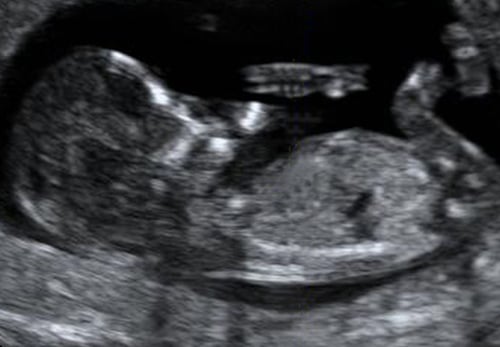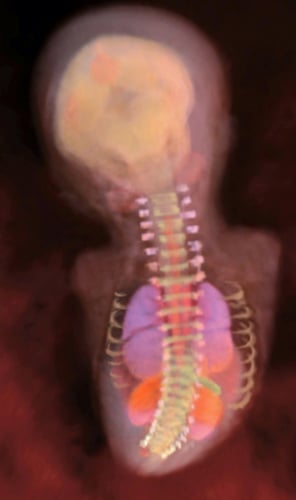You are 14 Weeks and 6 Days 176 days to go…
The neural tube, the basis of your baby’s spinal cord, developed in the very early weeks; now the spinal cord is fully formed.
Your baby today
Your baby is starting to swallow amniotic fluid more regularly:
this enters the stomach (seen here as a dark circle in the center of the
abdomen). The tiny bladder is also visible as a black fluid-filled
structure within the lower pelvis.

Nerves from your baby’s spinal cord
are linked to each set of vertebrae, but as your baby lengthens the
spinal cord does not grow at the same rate, and the lower tip ends up
lying at the mid-lumbar level, half way between the hips and lowest rib.
Below the mid-lumbar
level, the nerves leaving the spinal cord have lengthened so that they
still exit between the lowest vertebrae. In adult life, the cord will
end slightly higher than in the newborn baby. Because the spinal cord
does not extend the entire length of the vertebral canal, a fluid-filled
space fills the lower portion.
By the end of this week,
your baby is able to use fat as a source of energy. This isn’t, however,
an important source of energy because that need is met largely by
glucose crossing the placenta from your bloodstream. Free fatty acids in
your circulation easily cross the placenta to your baby and are used
for organ growth, forming cell walls, making myelin sheaths around
nerves to insulate them, and for many other functions.
Cholesterol is not
only supplied to your unborn baby via the placenta, but he is also
forming it within his own body. For this reason, your cholesterol level
bears little relation to your baby’s, which needs to be high for your
baby to produce fat, especially in the first few months of pregnancy.
In this computer-generated image,
the internal organs of the fetus can be seen. The skull, spine, and rib
cage are also clearly visible. The lungs (pink) are protected by the
rib cage; the kidneys (red) are below.

Your baby could be tuning in to your favorite TV show!
Research examined babies of mothers who watched the Australian show, Neighbours,
while pregnant alongside women who didn’t. After the birth those babies
who had heard the music in the uterus became quiet and “paid attention”
to the tune, while the other group of babies ignored it.
… Doctor
| Q: |
When can my baby first suck his thumb?
|
| A: |
Ultrasound scans have shown unborn babies sucking their thumbs
from as early as 12–14 weeks of pregnancy. However, this is likely to
be a reflex at this stage as the brain does not have any conscious
control over movement until the fetus is much more developed later on in
pregnancy.
Some research has
suggested that if an unborn baby shows a preference for sucking, for
example, his right thumb, then he will prefer to lie with his head
turned to the right after the birth. The same research suggested that
this preference could be used to predict right- or left-handedness in
the baby as he grows older.
|
You are 15 Weeks Exactly 175 days to go…
It’s worthwhile finding comfortable sleeping positions now; these will stand you in good stead throughout pregnancy.
Your baby today
This profile view shows that the bridge of the nose is shallow
and the eyes are still dominating the face. The jaw is lengthening and
the chin held away from the chest. The hands (with outstretched fingers)
are in a common position—close to the face.

Your belly will be getting bigger
by the day and, as a result, you may find it increasingly difficult to
get comfortable when you’re lying down, especially during the night.
You should avoid sleeping
on your back in the second half of your pregnancy, so start practicing
some new positions now. This is because the weight of your uterus will
press on the major veins that return blood to your heart, which may
result in dizziness, low blood pressure, and possibly a reduction in
blood flow to the uterus. Ideally, lie on your left side (although it
will do you or your baby no harm to lie on your right side) since this
is actually good for you and the baby. It improves blood flow to the
placenta and helps your kidneys eliminate fluids and waste products.
Don’t worry if you wake to find you’re lying on your back: just roll
onto your side and support yourself with pillows if necessary.
It’s fine to lie on your
front if you prefer (your baby is safely cushioned in the amniotic
fluid), but the bigger you get, the more difficult this will become.
… Your baby
Quiet times
Times when you can focus quietly
on your baby are precious bonding opportunities and a great way to
relax. You may want to visualize your baby floating in the amniotic
fluid.
Try this “butterfly”
pose with the soles of your feet together. Place your hands on your
abdomen and massage your baby using different strokes. Think of your
baby and shed your preoccupations with each out-breath.

… Doctor
| Q: |
My doctor is great but she’s always in a hurry. How can I get her to answer my questions?
|
| A: |
This is a common problem. Doctors’ practices are often very
busy, with lots of women for the doctor to see. As a result, many
doctors allow only a certain amount of time for each
appointment—sometimes barely enough time to go through the basic
physical checkup. However, it is important that your questions are
addressed and it may be helpful to write them down so that you remember
what you want to ask. If your doctor doesn’t have time to discuss the
issues during your appointment, ask her to arrange to talk to you at a
mutually convenient time. This could be in the form of a phone call, or
another appointment at her office. Or she may be able to direct you to
other sources of information such as books, websites, or other
health-care professionals.
It’s a crucial part
of your prenatal care that you feel comfortable with your caregivers
and are given the opportunity to discuss any questions you have or
issues that arise since they will be involved with your labor and
delivery, which is a very important time for you. |